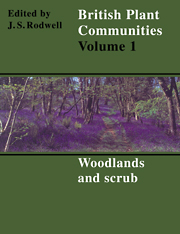Book contents
- Frontmatter
- Contents
- List of Figures
- Foreword
- Preface and Acknowledgements
- Preamble
- General Introduction
- Woodlands and Scrub
- Introduction to Woodlands and Scrub
- Key To Woodlands and Scrub
- Community Descriptions
- W1 Salix Cinerea-Galium Palustre woodland
- W2 Salix Cinerea-Betula Pubescens-Phragmites Australis Woodland
- W3 Salix Pentandra-Carex Rostrata Woodland
- W4 Betula Pubescens-Molinia Caerulea Woodland
- W5 Alnus Glutinosa-Carex Paniculata Woodland
- W6 Alnus Glutinosa-Urtica Jzozca Woodland
- W7 Ainus Glutinosa-Fraxinus Excelsior-Lysimachia Nemorum Woodland
- W8 Fraxinus Excelsior-Acer Campestre-Mercurialis Perennis Woodland
- W9 Fraxinus Excelsior-Sorbus Aucuparia-Mercurialis Perennis Woodland
- W10 Quereus Robur-Pteridium Aquilinum-Rubus Fruticosus Woodland
- W11 Quereus Petraea-Betula Pubescens-Oxalis Acetosella Woodland
- W12 Fagus Sylvatica-Mercurialis Perennis Woodland
- W13 Taxus Baccata Woodland
- W14 Fagus Sylvatica-Rubus Fruticosus Woodland
- W15 Fagus Sylvatica-Deschampsia Flexuosa Woodland
- W16 Quereus spp.-Betula spp.-Deschampsia Flexuosa Woodland
- W17 Quereus Petraea-Betula Pubescens-Dicranum Majus Woodland
- W18 Pinus Sylvestris-Hylocomium Splendens Woodland
- W19 Juniperus Communis Ssp. Communis-Oxalis Acetosella Woodland
- W20 Salix Lapponum-Luzula Sylvatica Scrub
- W21 Crataegus monogyna-Hedera helix scrub
- W22 Prunus Spinosa-Rubus Fruticosus Scrub
- W23 Ulex Europaeus-Rubus Fruticosus Scrub
- W24 Rubus Fruticosus-Holcus Lanatus Underscrub
- W25 Pteridium Aquilinum-Rubus Fruticosus Underscrub
- Index of Synonyms to Woodlands and Scrub
- Index of Species in Woodlands and Scrub
- Bibliography
W6 - Alnus Glutinosa-Urtica Jzozca Woodland
Published online by Cambridge University Press: 04 July 2020
- Frontmatter
- Contents
- List of Figures
- Foreword
- Preface and Acknowledgements
- Preamble
- General Introduction
- Woodlands and Scrub
- Introduction to Woodlands and Scrub
- Key To Woodlands and Scrub
- Community Descriptions
- W1 Salix Cinerea-Galium Palustre woodland
- W2 Salix Cinerea-Betula Pubescens-Phragmites Australis Woodland
- W3 Salix Pentandra-Carex Rostrata Woodland
- W4 Betula Pubescens-Molinia Caerulea Woodland
- W5 Alnus Glutinosa-Carex Paniculata Woodland
- W6 Alnus Glutinosa-Urtica Jzozca Woodland
- W7 Ainus Glutinosa-Fraxinus Excelsior-Lysimachia Nemorum Woodland
- W8 Fraxinus Excelsior-Acer Campestre-Mercurialis Perennis Woodland
- W9 Fraxinus Excelsior-Sorbus Aucuparia-Mercurialis Perennis Woodland
- W10 Quereus Robur-Pteridium Aquilinum-Rubus Fruticosus Woodland
- W11 Quereus Petraea-Betula Pubescens-Oxalis Acetosella Woodland
- W12 Fagus Sylvatica-Mercurialis Perennis Woodland
- W13 Taxus Baccata Woodland
- W14 Fagus Sylvatica-Rubus Fruticosus Woodland
- W15 Fagus Sylvatica-Deschampsia Flexuosa Woodland
- W16 Quereus spp.-Betula spp.-Deschampsia Flexuosa Woodland
- W17 Quereus Petraea-Betula Pubescens-Dicranum Majus Woodland
- W18 Pinus Sylvestris-Hylocomium Splendens Woodland
- W19 Juniperus Communis Ssp. Communis-Oxalis Acetosella Woodland
- W20 Salix Lapponum-Luzula Sylvatica Scrub
- W21 Crataegus monogyna-Hedera helix scrub
- W22 Prunus Spinosa-Rubus Fruticosus Scrub
- W23 Ulex Europaeus-Rubus Fruticosus Scrub
- W24 Rubus Fruticosus-Holcus Lanatus Underscrub
- W25 Pteridium Aquilinum-Rubus Fruticosus Underscrub
- Index of Synonyms to Woodlands and Scrub
- Index of Species in Woodlands and Scrub
- Bibliography
Summary
Synonymy
Valley fen woods Farrow 1915 p.p.; Betulo-Alnetum Clapham in Tansley 1939; Woodwalton Birch wood Poore 1956b p.p.; Valley fen alderwoods Haslam 1965 p.p.; Alnus-Salix woodland XXi & XXii Meres Report 1980; Alnus-Salix-Betula woodland XXi Meres Report 1980; Fen Woodlands B, C & D Fitter et al. 1980; Alder stand types 7Aa & 7Ab Peterken 1981.
Constant species
Alnus glutinosa, Urtica dioica.
Physiognomy
The Alnus glutinosa-Urtica dioica woodland is a rather ill-defined community which brings together a variety of canopies dominated by Alnus glutinosa, Salix spp. and Betula pubescens beneath which the rich assemblages of swamp and fen herbs characteristic of many of our wetter woods are replaced by a species-poor, though quite distinctive, field layer. There is considerable floristic and physiognomic diversity among the woodland types included here and, at first sight, it is often the peculiarities of stands which impress the visitor more than their underlying similarities. Nonetheless, there are sound ecological reasons for both the general speciespoverty of these woodlands and for what little they have in common and it seems best to treat them within a single, rather disparate, group.
Alnus glutinosa is by far the commonest tree throughout and it remains frequent in all but the driest stands. In the wetter woodlands included here, it is often an overwhelming dominant, forming an even-topped and usually closed canopy of well-grown, usually multistemmed trees. In one sub-community, it is replaced as the most abundant tree by Salix fragilis. In the drier types of woodland within the community, Betula pubescens becomes increasingly frequent and locally dominant and Pinus sylvestris is an important invader or planted canopy replacement. Other tree species are generally uncommon but Populus nigra var. betulifolia is a very distinctive associate in some stands and it can attain a grand stature here with its black bossed trunk and irregular branches arching downwards. This tree is probably native in southern England and, as on the Continent, this community perhaps provides its natural woodland locus. There is occasionally some Acer pseudoplatanus or Fraxinus excelsior and sometimes a little Quercus robur.
- Type
- Chapter
- Information
- British Plant Communities , pp. 91 - 101Publisher: Cambridge University PressPrint publication year: 1991



